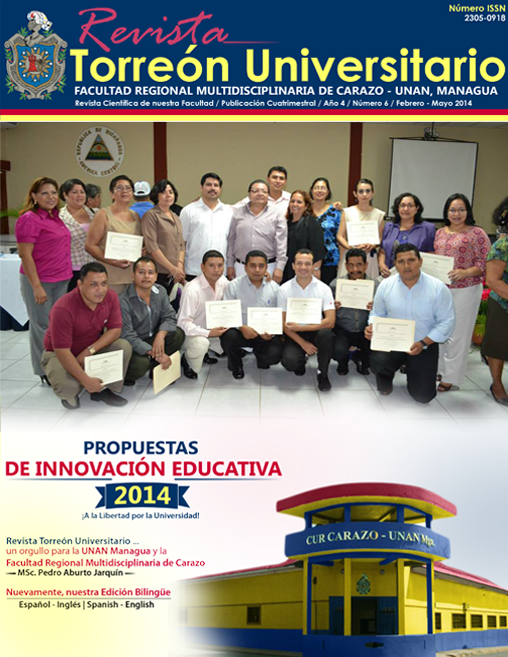Didactic strategies for teaching writing
Keywords:
Didactic strategies, Writing, Didactic Unit, Cooperative Work, School EvaluationAbstract
The objective of this research is to show the effectiveness of the implementation of didactic strategies to improve the difficulties of editing essays in the communicative field of the students. In it are determined the strategies that were applied in ten class sessions in the ninth grade classroom in high school in the Institute Juan XXIII in San Marcos, Carazo. The analytic and descriptive study type is found in Hernández Pina et al (2008). It was applied to two questionnaires, a self-evaluation, a co-evaluation, an evaluation and seven flyers elaborated from which three were chosen for the data analysis. The results showed that the implementation of didactic strategies suitable for the teachers of Spanish Language and Literature lessened the difficulties of editing texts in the communicative field of the students.
Downloads
References
ALBAT (1899) en Cerda & Zamora (2012) “La importancia de desarrollar las habilidades de redacción en la universidad”. Cuadernos pedagógicos para la docencia universitaria. Nro. 2. Pág. 8. Disponible en: http://vrac.uca.edu.ni/fordoc/wp-content/uploads/2012/08/leer2.pdf
ALVARADO, M. ET AL (2006): “La lingüística del texto (Teorías y enfoques en la enseñanza de la escritura, la gramática y la literatura”. Disponible en:http://www.terras.edu.ar/aula/tecnicatura/4/biblio/4CORTES-Marina-Los-textos-marcos-teoricos-y-practicas.pdf
ATORRESI, A. (2010): “Escritura: Un estudio de las habilidades de los estudiantes de América Latina y el Caribe”. Organización de las Naciones Unidas para la Educación la Ciencia y la Cultura. SERCE (Segundo Estudio Regional Comparativo y Explicativo). Disponible en: http://unesdoc.unesco.org/images/0019/001919/191925s.pdf
CAMPOS CAMPOS, Y. (2000): “Tipos de estrategias de enseñanza – aprendizaje”. Estrategias Didácticas Apoyadas en Tecnología. Disponible en: www.uv.mx/personal/yvelasco/files/2012/08/Estrategias-E-A.pdf
CERDA, M. E. & ZAMORA, H. (2012) “La importancia de desarrollar las habilidades de redacción en la universidad”. Cuadernos pedagógicos para la docencia universitaria. Nro. 2. Pág. 8. Disponible en: http://vrac.uca.edu.ni/fordoc/wp-content/uploads/2012/08/leer2.pdf
CÓRDOBA, M. & GARZÓN, Z. (2001): “La producción de textos argumentativos en los estudiantes de grado noveno de Educación Básica Secundaria”. Colombia. Disponible en: http://edudistancia2001.wikispaces.com/file/view/la+produccion+de+textos+argumentativos+en+los+estudiantes+de+grado+noveno+de+educacion+basica+secundaria.pdf
HERNÁNDEZ PINA, F. ET AL (s.f.): “Análisis de datos cualitativos”. Disponible en: http://ocw.um.es/cc.-sociales/metodologias-de-la-investigacion-en-educacion/material-de-clase-1/t1.5.analisis-datos-cualitativos.pdf
INSTITUTO EDUCATIVO MODELO (2008): “El trabajo en grupo en el aula”. Disponible en: http://www.educativomodelo.edu.ar/boletin/Julio2008/TrabajoenGrupo.pdff
MINISTERIO DE EDUCACIÓN (MECD) (2004): “El desarrollo de la educación”.Informe Nacional de Nicaragua Disponible en: http://www.ibe.unesco.org/International/ICE47/English/Natreps/reports/nicaragua_part_1.pdf
MINISTERIO DE EDUCACIÓN (MINED) (2009): “Programa de estudio de Lengua y Literatura. Educación Secundaria. 7mo., 8vo. y 9no. Grado”. División general de currículo y desarrollo tecnológico. Nicaragua. pp. 250
MINISTERIO DE EDUCACIÓN. (2009): “Diseño curricular del subsistema de la educación básica y media nicaragüense”. Currículo Nacional Básico. División general de currículo y desarrollo tecnológico Nicaragua.
NUSSBAUM, L. (2005): “Competencia comunicativa y habilidades parciales”. Universidad Autónoma de Barcelona. Disponible en: http://ldei.ugr.es/cddi/uploads/tesis/VilaBanos2005.pdf
PACHECO VILLAMONTE, S. (2005): “Estrategias didácticas para fortalecer la escritura en lengua maya de alumnos de segundo grado de primaria indígena”. México. Disponible en: http://biblioteca.ajusco.upn.mx/pdf/23229.pdf
RABAZO, M. & MORENO, J. (2005): “La composición escrita: aportaciones y recomendaciones legales para su enseñanza en educación primaria”. Revista electrónica de investigación psicoeducativa y psicopedagógica ISSN: 1696-2095. España. Nro. 6-3 pp. 127-157. Disponible en: http://www.investigacion-psicopedagogica.org/revista/new/ContadorArticulo.php?65
RAMOS, M. (2011): “El problema de comprensión y producción de textos en el Perú”. Revista Digital de Investigación en Docencia Universitaria / Año 5 – N°1- Dic. Disponible en: (Problemas en la conexión)
RODRÍGUEZ LARA, J. ET AL (2012): “La evaluación de los aprendizajes”. En diapositivas. Nicaragua.
ROSALES, D. (2005): “Estrategias didácticas para la enseñanza de la escritura dirigidas a docentes especialistas que laboran en el área de “dificultades de aprendizaje”. Disponible en: http://www.docstoc.com/docs/47913104/estrategias-did%c3%81cticas-para-la-ense%c3%91anza-de-la-escritura-dirigidas
SIERRA DE LA OSSA, K. (2010): “Estrategias para mejorar el proceso de escritura en el desempeño escolar en algunos estudiantes de transición a de la institución educativa escuela normal superior de montería, durante el año lectivo 2010”. Disponible en: http://primerejercicioinvestigativo.blogspot.com/2011/03/estrategias-para-mejorar-el-proceso-de.html
SISTEMA EDUCATIVO BOLIVARIANO (2008 citado en NÚÑEZ, J. (s.f.): “Conceptos básicos de la evaluación de los aprendizajes bajo el enfoque constructivista”. Disponible en: http://www.monografias.com/trabajos65/aprendizaje-enfoque-constructivista/aprendizaje-enfoque-constructivista2.shtml
UNIDAD DE MEDICIÓN DE LA CALIDAD EDUCATIVA (2006): “Evaluación Nacional del Rendimiento Estudiantil 2004”. Perú. Disponible en: http://www2.minedu.gob.pe/umc/admin/images/documentos/archivo_20.pdf
Downloads
Published
Issue
Section
License
Copyright (c) 2014 National Autonomous University of Nicaragua, Managua

This work is licensed under a Creative Commons Attribution-NonCommercial-NoDerivatives 4.0 International License.
The authors who publish in this journal agree to the following terms.
- The author or authors of the articles, essays or research grant the National Autonomous University of Nicaragua, Managua (UNAN-Managua) the editing rights (copyright) of the submitted work, therefore the University has the exclusive right to publish the article for the entire copyright period.
- These copyrights/authors authorize Torreón Universitario Magazine and the University to edit and disseminate/publish the article in said Magazine, including printed and electronic reproduction, storage, retrieval and any other type of publication, and sources of secondary information as services. of summaries and databases, they also empower it to protect the article against unauthorized use for dissemination by printed or electronic media (PDF, HTML, EPUB, XML or others).
License for use of content
The magazine uses the Creative Commons Attribution-NonCommercial-NoDerivs 4.0 International License.
Under this statement:

This journal is licensed under a Creative Commons Attribution-NonCommercial-NoDerivatives 4.0 International License. It can be copied, distributed and transmitted publicly as long as the author and source are cited (Revista Torreón Universitario), it should not be modified or used for any commercial purpose. The full license can be found at http://creativecommons.org/licenses/by-nc-nd/4.0/.



